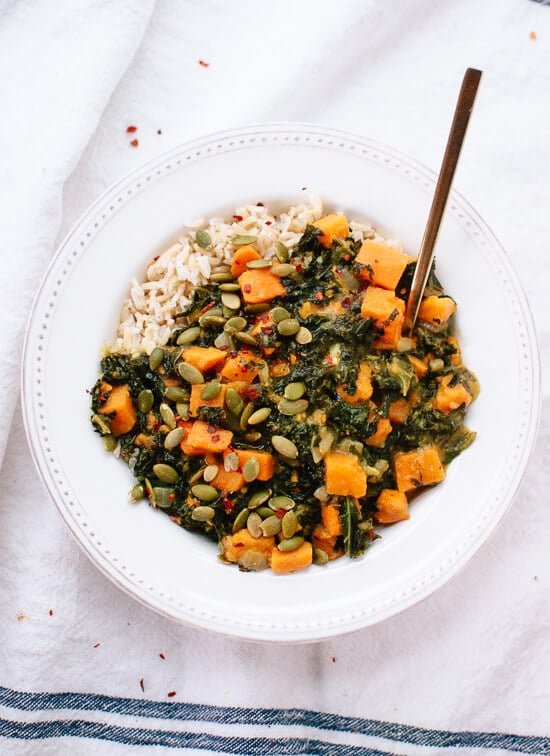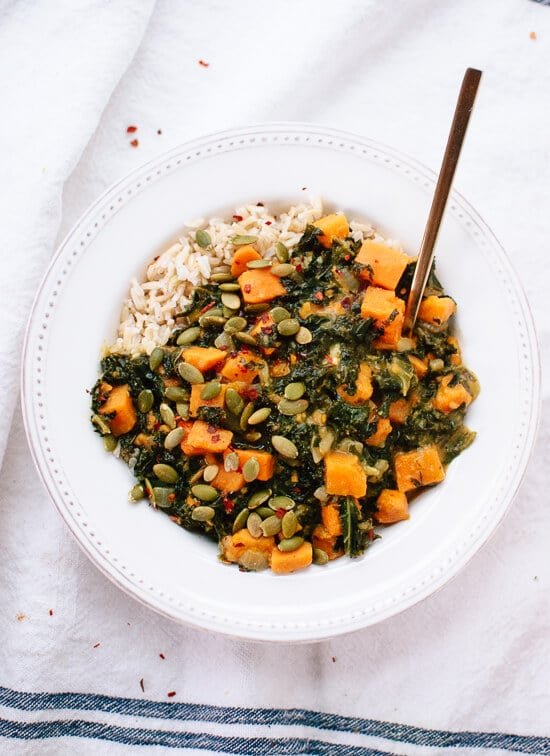
I’m finally back in Kansas City. I arrived home on Tuesday, to a house full of all the things I haven’t used in the past month. I almost hoped I’d greet the things like long-lost friends (oh hello, favorite knee-length boots!) but I really just sighed at the sight of those things, those burdens that I pack up and carry from place to place.
If you took away the blog-related cookbooks and photography props (code word for so many breakable plates and glasses), maybe it would be a more reasonable amount of stuff for one person. My closet is definitely overstuffed, however. The end of winter is nearing and I’m feeling some pressure to wear all of my cold weather apparel at least once before it goes. I have too much!
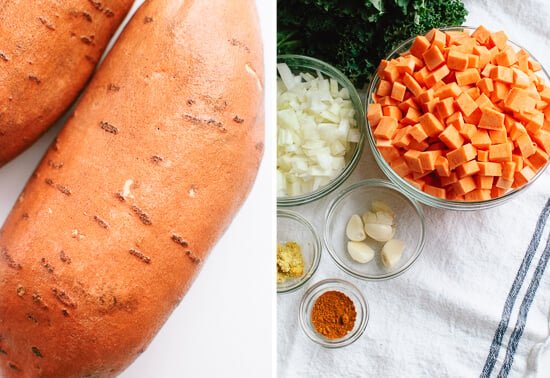
I think about minimalism a lot—how much I love the concept and how difficult it is to put into practice. I’m too attached to my things. I often find myself looking around my place and wondering, how much does one person really need? Is this a reasonable amount for one person?
I’ve watched my grandmothers downsize into smaller, more manageable living situations and I think about all of the care and time that went into filling their homes and the difficulties in downsizing. Some of that is inevitable, but I don’t want my life to be characterized by the getting and getting rid of things.
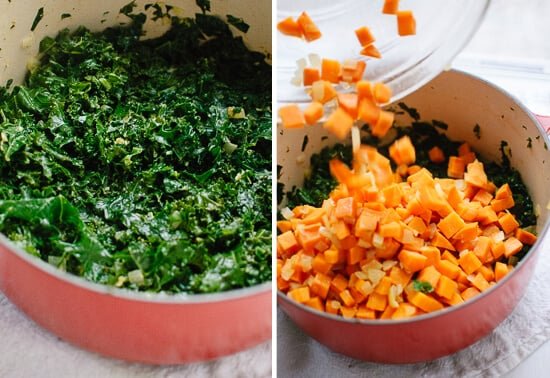
Today’s recipe comes from America’s Test Kitchen’s newest book, The Complete Vegetarian Cookbook. I adore America’s Test Kitchen so I couldn’t say no to their new cookbook, which includes over 700 impeccably well-tested vegetarian recipes. Basically, any recipe you could think of to make is in this book. I’d even go so far as to say that if you’re going to own only one vegetarian cookbook, this is the book for you. I’m eyeing my heavy shelves of cookbooks now and owning only one cookbook is a lovely thought!
This recipe turned out to be more work than I bargained for, but it was absolutely worth the effort. That’s the beauty of America’s Test Kitchen recipes—they’ve been tested every which way, so the only trick, if you even want to call it that, is to trust their methods and carry them through. I deviated from the recipe by using sweet potato instead of butternut squash. In hindsight, I think butternut might be the better choice, although I do love the sweet potato version.
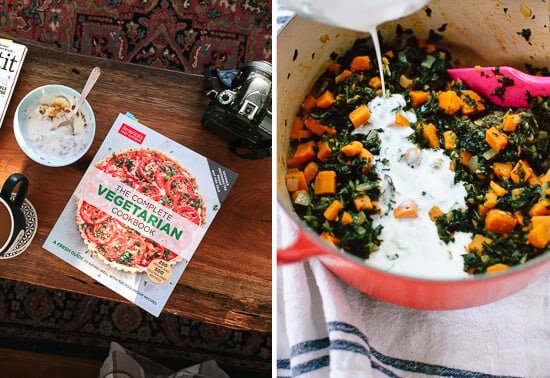
I was drawn to the recipe because it sounded very similar to an original recipe I attempted a couple of times in Austin that never turned out quite right. Those ATK cooks nailed it. It’s a stewy concoction that is loaded with greens (two bunches’ worth!), cooked down into hearty, comforting goodness. I never would have thought to add toasted pepitas, but they round out the dish perfectly. It’s not the prettiest of dishes, but trust me, it’s delicious!
The giveaway is now closed! Congratulations to Annie, the winner, whose go-to is a noodle bowl with tempeh! I have one copy of America’s Test Kitchen’s The Complete Vegetarian Cookbook to send to one lucky reader. To enter, leave one comment below and tell me about your go-to meatless recipe! Only one comment per person, please. I’ll randomly select a winner next Wednesday at midnight CST. Good luck!
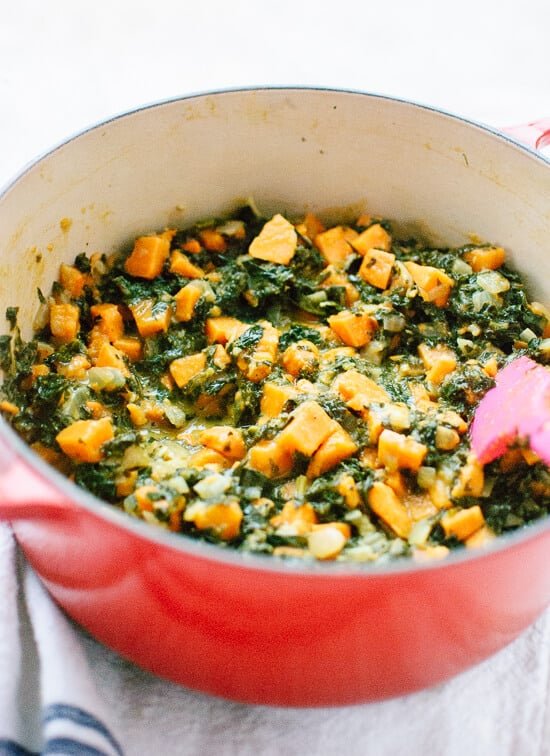
Le Creuset Cast Iron 5 1/2-Quart Dutch Oven
Wusthof 7-Inch Santoku Knife
Microplane Grater
▸ For more of my favorite cooking tools, shop my healthy kitchen!
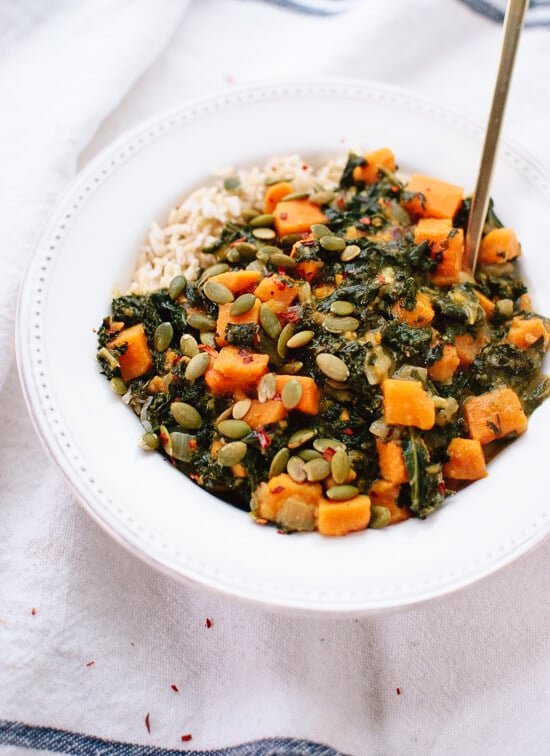
Coconut Curried Kale and Sweet Potato
Hearty braised and curried kale with sweet potato makes a delicious wintertime meal! This healthy dish is vegan, dairy-free, and gluten-free. Be sure to have your ingredients prepped before you start cooking. Recipe yields 6 generous servings—I also like it as a stew without the rice.
Rice
Braised kale and sweet potato
- 3 tablespoons extra-virgin olive oil, divided
- 1 medium yellow onion, chopped
- 1 teaspoon fine salt, divided, more to taste
- 2 pounds sweet potato (about 3 medium) or 1 butternut squash, peeled and sliced into ½-inch cubes
- 3 large garlic cloves, pressed or minced
- 2 teaspoons finely grated fresh ginger
- 1 teaspoon curry powder
- 1 large bunch of kale (about 8 ounces), stems removed and chopped
- 2 cups vegetable broth or water
- 1 can (14 ounces) full-fat coconut milk, divided
- 1 tablespoon lime juice
- ⅓ cup pepitas (green pumpkin seeds)
- Freshly ground black pepper, to taste
- Red pepper flakes (optional), to taste
- To cook the rice, bring a large pot of water to boil. Add the rinsed rice and continue simmering for 30 minutes, reducing the heat as necessary to prevent overflow. Turn off the heat, drain the rice, and return the rice to the pot. Cover and let the rice rest for 10 minutes or longer, until you’re ready to serve.
- Meanwhile, warm 2 tablespoons olive oil in a Dutch oven over medium heat until shimmering. Add the onion and ½ teaspoon of the salt. Cook, stirring frequently, until softened, about 5 minutes. Add the sweet potato, cover, and cook, stirring occasionally, until the sweet potato is bright orange (or until the butternut is just beginning to brown), about 8 minutes. Transfer the mixture to a bowl for now.
- Add 1 tablespoon olive oil to the pot and raise the heat to medium-high. Add the garlic, ginger and curry powder and cook, stirring constantly, until fragrant, about 30 seconds. Add the kale, broth, all but ½ cup coconut milk, and ½ teaspoon of the salt. Stir to combine.
- Cover the pot, reduce the heat to medium-low, and cook, stirring occasionally, until the kale is wilted, about 7 to 10 minutes. Add the sweet potato mixture, cover, and continue to cook until the kale and sweet potato are tender, 10 to 20 minutes.
- Meanwhile, toast the pepitas in a medium skillet over medium-low heat, stirring frequently, until they’re fragrant and making little popping noises, about 3 to 5 minutes. Transfer to a bowl to cool.
- Once the kale and sweet potato are tender, uncover the pot and increase the heat to medium-high. Cook, stirring occasionally, until the sauce has thickened, about 2 to 5 minutes.
- Remove the pot from the heat and stir in the remaining coconut milk. Add the lime juice and season with salt, pepper and optional red pepper flakes, to taste. Divide rice into bowls, then top with kale mixture and a generous sprinkling of pepitas before serving. This recipe keeps well in the refrigerator, covered, for up to 4 days (or freeze portions up to 6 months).
Notes
Recipe adapted from The Complete Vegetarian Cookbook by America’s Test Kitchen.
Recipe edits: In 2025, I tweaked this recipe to improve the overall flavor and texture. I increased the amount of broth, layered in more salt, reduced the amount of kale, and edited the recipe for clarity.
Nutrition
The information shown is an estimate provided by an online nutrition calculator. It should not be considered a substitute for a professional nutritionist’s advice. See our full nutrition disclosure here.

